
The Karabakh Khanate was a khanate under Iranian and later Russian suzerainty, which controlled the historical region of Karabakh, now divided between modern-day Armenia and Azerbaijan. In terms of structure, the Karabakh Khanate was a miniature version of Iranian kingship. The administrative and literary language in Karabakh until the end of the 19th century was Persian, with Arabic being used only for religious studies, despite the fact that most of the Muslims in the region spoke a Turkic dialect.

The Baku Khanate, was a khanate under Iranian suzerainty, which controlled the city of Baku and its surroundings from 1747 to 1806.

The Quba Khanate was one of the most significant semi-independent khanates that existed from 1747 to 1806, under Iranian suzerainty. It bordered the Caspian Sea to the east, Derbent Khanate to the north, Shaki Khanate to the west, and Baku and Shirvan Khanates to the south. In 1755 it captured Salyan from the Karabakh Khanate.
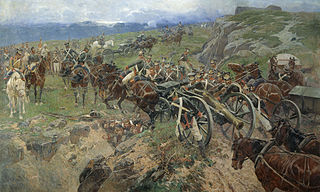
The Russo-Persian War of 1804–1813 was one of the many wars between the Persian Empire and Imperial Russia, and, like many of their other conflicts, began as a territorial dispute. The new Persian king, Fath Ali Shah Qajar, wanted to consolidate the northernmost reaches of his kingdom—modern-day Georgia—which had been annexed by Tsar Paul I several years after the Russo-Persian War of 1796. Like his Persian counterpart, the Tsar Alexander I was also new to the throne and equally determined to control the disputed territories.

The Ganja Khanate was a khanate under Iranian suzerainty, which controlled the town of Ganja and its surroundings, now located in present-day Azerbaijan.

The Shaki Khanate was a khanate under Iranian and later Russian suzerainty, which controlled the town of Shaki and its surroundings, now located in present-day Azerbaijan.

The Russo-Persian War of 1826–1828 was the last major military conflict between the Russian Empire and Qajar Iran, which was fought over territorial disputes in the South Caucasus region.
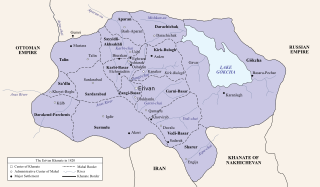
The Erivan Khanate, also known as Chokhur-e Sa'd, was a khanate that was established in Afsharid Iran in the 18th century. It covered an area of roughly 19,500 km2, and corresponded to most of present-day central Armenia, the Iğdır Province and the Kars Province's Kağızman district in present-day Turkey and the Sharur and Sadarak districts of the Nakhchivan Autonomous Republic of present-day Azerbaijan.

Prince Pavel Dmitriyevich Tsitsianov was an Imperial Russian general of Georgian noble origin who played a prominent role in the Russian conquest of the South Caucasus. He served as the Russian Commander-in-chief in the Caucasus from 1802 to 1806 and commanded Russian forces in the Russo-Persian War of 1804–1813 until his assassination near Baku in 1806.
Ibrahim Khalil Khan Javanshir was the second khan of the Karabakh Khanate from the Javanshir family. He was the son and successor of Panah-Ali khan Javanshir.
Javad Khan Qajar ; c. 1748 – 1804) was a member of Ziyadoghlu Qajar, a clan of the Qajar tribe, as well as the sixth and the last khan of the Ganja Khanate from 1786 to 1804 before it was lost to Russia.

The khanates of the Caucasus, also known as the Azerbaijani khanates, Persian khanates, or Iranian Khanates, were various administrative units in the South Caucasus governed by a hereditary or appointed ruler under the official rule of Iran. The title of the ruler was khan, which was identical to the Ottoman rank of pasha. Following the assassination of Nader Shah in 1747, internal chaos erupted in Iran, particularly in the South Caucasus, where semi-autonomous khanates emerged as a result of the lack of a centralized government. The khans neither had territorial or religious unity, nor an ethnic/national identity. They were mostly interested in preserving their positions and income.

Hossein Qoli Khan Qajar Sardar Iravani was a statesman and commander in Qajar Iran, who was the last khan (governor) of the Erivan Khanate from 1807 to 1828.
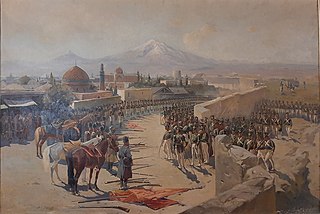
The Russian conquest of the Caucasus mainly occurred between 1800 and 1864. The Russian Empire sought to control the region between the Black Sea and Caspian Sea. South of the mountains was the territory that is modern Armenia, Azerbaijan, Georgia, and parts of Iran and Turkey. North of the mountains was the North Caucasus region of modern Russia. The difficult conquest of the intervening mountains is known as the Caucasian War. Multiple wars were fought against the local rulers of the regions, as well as the dominant powers, the Ottoman Empire and Qajar Iran, for control. By 1864 the last regions were brought under Russian control.
Fatali Khan or Fath Ali Khan of Quba was a khan of the Quba Khanate (1758–1789) who also managed to dominate the Derbent, Baku, Talysh and Shirvan Khanates, as well as the Salyan Sultanate during much of his reign.
Hajji Mohammad Ali Khan was the first khan (governor) of the Shirvan Khanate, ruling from 1761 to 1763. With the permission of the Zand ruler Karim Khan Zand, he was put in power by the inhabitants of Old Shamakhi. He governed Shirvan until 1763, when Fath-Ali Khan of Quba gained influence there, and appointed his own governors, such as Aghasi Beg and Askar Beg, both members of the same family.
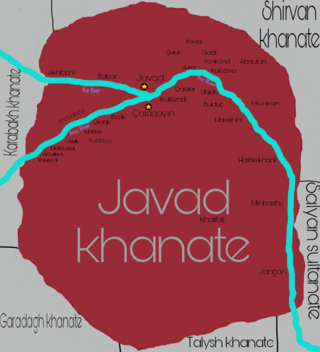
Javad Khanate was a Caucasian khanate with its capital in the town of Javad. It extended from Javad on the Kura River southwest along the east side of the Aras River. It was bordered by the Shamakhy (north), Karabakh (west), Karadagh (southwest) and Talysh khanates (south), and the Salyan Sultanate (east), its territory lays within modern Azerbaijan.
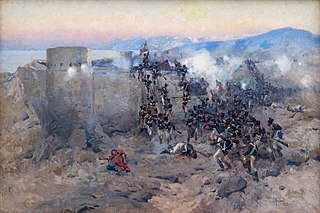
The siege of Lankaran took place from 7 January to 13 January 1813 during the Russo-Iranian War of 1804–1813. Lankaran, a city in the Talish region, was previously held by Mir-Mostafa Khan of the Talysh Khanate, a subject of Iran. However, due to his defiance, he was ousted from the city by Iranian forces in August 1812. Now directly held by the Iranians, the city was soon besieged by the Russian commander Pyotr Kotlyarevsky, who had recently defeated the Iranian crown-prince Abbas Mirza at the battle of Aslanduz.
Mostafa Khan was the last khan of Shirvan, until 1820.
Agha Kishi Beg was the khan of the Shaki Khanate from 1755 to 1759.















